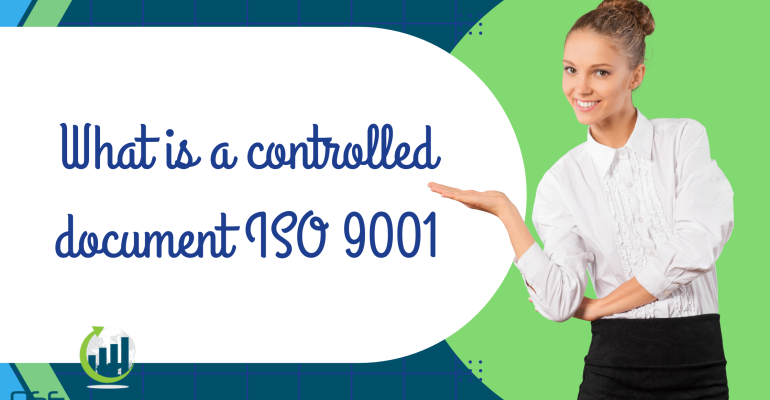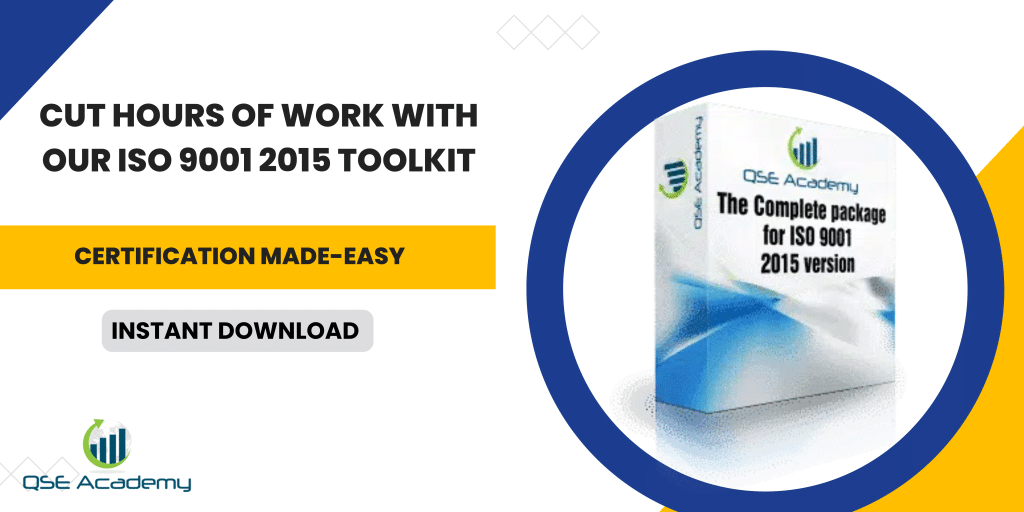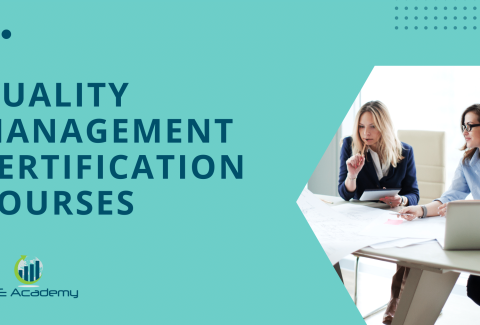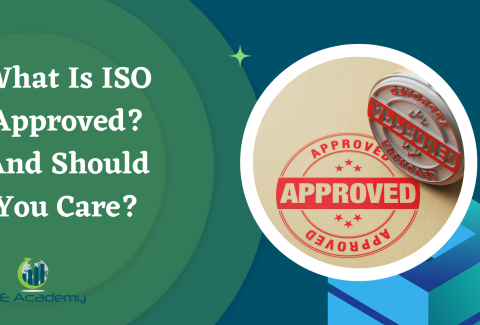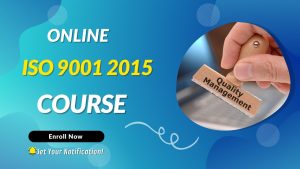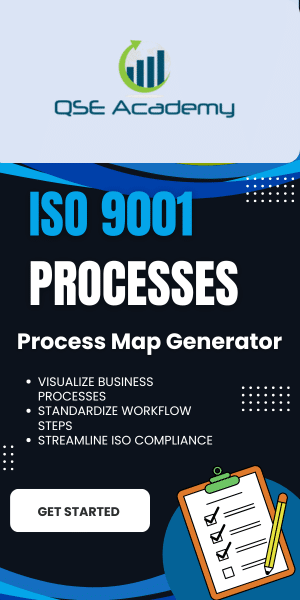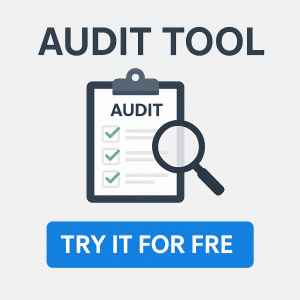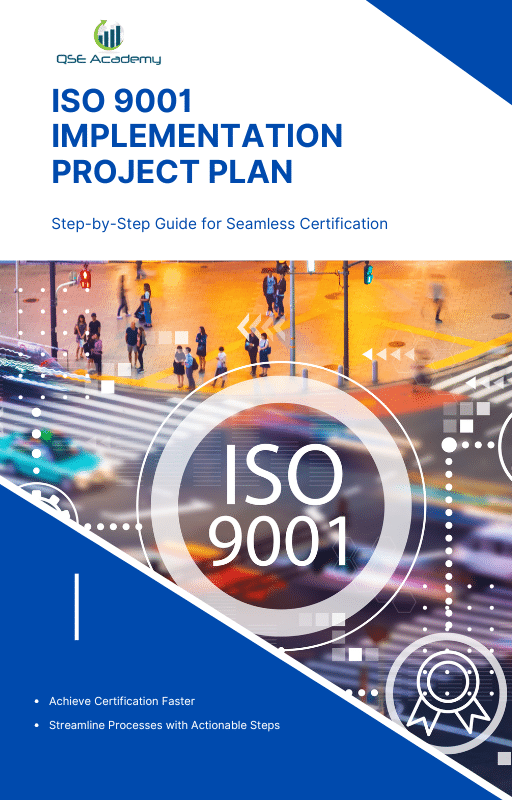What is a controlled document ISO 9001?
Last Updated on October 13, 2025 by Hafsa J.
What is a controlled document ISO 9001?
Let’s start with a question: Have you ever worked in a place where everyone seemed to have their own way of doing things, and no one could agree on the “right” process? It’s frustrating, isn’t it? That’s exactly the kind of chaos ISO 9001 aims to prevent. And one of the key tools it uses to create order and consistency is something called a controlled document.
So, what is a controlled document ISO 9001, and why is it such a big deal? In the simplest terms, a controlled document is any file or record that helps your business maintain quality standards. These can be things like policies, procedures, or manuals that tell everyone in your organization how to get things done the right way. But here’s the catch: these documents aren’t just floating around in random folders or desks. They’re carefully managed to make sure they’re always accurate, up-to-date, and accessible to the right people.
ISO 9001, the international standard for quality management systems, places a lot of emphasis on controlling documents because they’re the backbone of a well-organized and efficient operation. After all, how can you deliver consistent quality if everyone’s working off outdated or conflicting instructions? That’s why controlled documents ISO 9001 are so essential—they help ensure your team is always on the same page, no matter the task.
Stick around, and we’ll dive deeper into what controlled documents are, how they work in ISO 9001, and why they’re a game-changer for businesses aiming to keep quality and compliance front and center. Trust me, this isn’t just about ticking boxes for audits—it’s about making your life easier and your operations smoother. Ready? Let’s get into it!
Understanding the Basics of Controlled Document ISO 9001
Alright, let’s take a closer look at what we mean when we talk about a controlled document ISO 9001. Think of it like this: A controlled document is your go-to, reliable guide for getting things done in a way that’s consistent, efficient, and up to standard. Whether it’s a procedure for handling customer complaints or a checklist for quality inspections, these documents act as the backbone of a well-oiled quality management system (QMS).
What Exactly Is a Controlled Document?
In simple terms, a controlled document is any file that’s essential to running your business smoothly and meeting ISO 9001 requirements. These aren’t just ordinary documents you jot down and forget about. Controlled documents are created, approved, and carefully managed so they’re always accurate and accessible when needed.
Imagine you’re baking a cake, and you’re following a recipe. Now, what if the recipe you’re using is outdated or has a step missing? That’s a disaster waiting to happen, right? Controlled documents work the same way—they ensure everyone in your team has the right recipe to follow, whether it’s for manufacturing, customer service, or internal processes.
Examples of controlled documents in an ISO 9001 system include:
- Quality manuals
- Work instructions
- Process flowcharts
- Training records
Each of these plays a key role in helping your organization maintain consistent quality and meet customer expectations.
Why Are Controlled Documents So Important in ISO 9001?
So, why all the fuss about controlled documents? It’s because they’re vital for achieving one of ISO 9001’s main goals: consistency. The whole idea behind ISO 9001 is to create a system where everyone knows what they’re doing and how to do it right—every single time. That’s where controlled documents come in.
Let’s say you’re running a team, and each member handles the same task differently. While that might seem fine at first, it often leads to errors, delays, or even customer complaints. By using controlled documents ISO 9001, you’re giving your team a single, reliable source of truth to follow. This means fewer mistakes, smoother operations, and happier customers.
Controlled documents also protect your organization from risks. Imagine a scenario where an outdated procedure leads to a product defect. That’s not just bad for business—it can also damage your reputation. With proper document control, you minimize these risks by ensuring only the latest, approved documents are in circulation.
Next, we’ll explore how ISO 9001 specifically defines and manages controlled documents and what makes this process so effective. But for now, just remember this: controlled documents aren’t just about following rules—they’re about setting your business up for success!
How Does ISO 9001 Define and Manage Controlled Documents?
Now that we know what a controlled document ISO 9001 is and why it’s so important, let’s get into how ISO 9001 actually handles these documents. Spoiler alert: it’s all about keeping things clear, organized, and up to date. ISO 9001 has specific requirements to make sure your controlled documents are managed effectively—and trust me, these steps can make your life so much easier.
What Are the Requirements for a Controlled Document ISO 9001?
ISO 9001 doesn’t leave you guessing. It lays out clear rules for managing controlled documents, especially in Clause 7.5, which focuses on documented information. Here’s the gist of what it says:
- Approval Before Use
Every controlled document needs to be reviewed and approved before it’s put into action. This ensures that only accurate, reliable information gets shared with your team. - Version Control
Have you ever accidentally worked on an old file because you didn’t know a newer one existed? It’s frustrating! ISO 9001 requires version control, which means every update or revision is tracked, so everyone knows they’re working with the latest and greatest version of a document. - Accessibility and Security
Controlled documents must be easily accessible to the people who need them—but not to everyone. ISO 9001 emphasizes balancing accessibility with security, so your documents don’t fall into the wrong hands or get edited by unauthorized users. - Updating and Archiving
When a document is updated, the changes must be clear, and the old version should either be archived or removed to avoid confusion. No more guessing which version to use!
By following these requirements, you’ll have a solid foundation for managing your controlled documents ISO 9001 style.
Key Elements of a Controlled Document System
A well-organized controlled document system isn’t just about having documents—it’s about managing them effectively. Here are some key elements that ISO 9001 recommends for keeping your system on track:
- Revision History
Think of this like a paper trail for your documents. Revision histories show who made changes, when they made them, and what those changes were. This not only keeps things transparent but also helps you trace back issues if something goes wrong. - Authorization Processes
Before any document becomes “official,” it needs to go through proper approvals. Whether it’s a manager, a department head, or a quality assurance officer, someone needs to sign off and say, “Yep, this is good to go.” - Document Labels and Identification
Each controlled document should be clearly labeled with a title, a unique number or code, and its revision status. This makes it easy to identify and retrieve the document you need without wasting time.
The Lifecycle of a Controlled Document ISO 9001
Here’s a quick breakdown of how a controlled document flows through its lifecycle in an ISO 9001 system:
- Creation
It all starts with drafting a document. This could be anything from a new procedure to an updated work instruction. The goal here is to create something that’s clear, accurate, and aligns with your quality objectives. - Review and Approval
Next, the draft goes through a review process. Once it’s approved, it becomes the official version and is distributed to the people who need it. - Implementation and Use
The document is put into action, guiding your team to follow standardized processes and maintain quality. - Revisions and Updates
Over time, processes change, and so should your documents. Controlled documents are regularly reviewed, revised, and updated to keep them relevant. - Archiving
When a document is no longer needed, it’s archived. This keeps your system tidy and prevents outdated information from causing confusion.
By following ISO 9001’s guidelines for controlled documents, you’re not just complying with a standard—you’re setting up your team for success. These processes make sure your documents stay accurate, secure, and useful, helping your business run like a well-oiled machine. And let’s be honest, who doesn’t want that?
Next, we’ll talk about practical tips for managing controlled documents ISO 9001 in real-world scenarios. Stay tuned!
Practical Tips for Managing Controlled Documents ISO 9001
Now that we’ve covered the basics of what a controlled document ISO 9001 is and how it’s managed, let’s talk about how to handle them in the real world. Whether you’re just starting out with ISO 9001 or looking to fine-tune your system, these tips will help you take control of your documents like a pro.
1. Start with a Clear Document Control Procedure
One of the first steps to mastering controlled documents is setting up a clear procedure for managing them. Think of this as your rulebook—it defines how documents are created, approved, updated, and even retired. A well-thought-out document control procedure ensures consistency and keeps things running smoothly.
Here’s what to include in your procedure:
- Who’s in charge? Assign responsibility for document control to specific roles or teams. This prevents the classic “I thought someone else was handling it” problem.
- How are changes managed? Define the process for reviewing and approving updates to your controlled documents.
- Where are documents stored? Make sure everyone knows where to find the latest version of a document. Centralized storage—whether physical or digital—is key for ISO 9001 compliance.
By laying out these details, you’ll create a strong foundation for managing controlled documents ISO 9001 style.
2. Avoid Common Mistakes with Controlled Documents
Even with the best intentions, mistakes can happen. Here are a few common pitfalls to watch out for—and how to avoid them:
- Outdated Documents in Circulation
This is a big no-no in ISO 9001. Always make sure old versions of controlled documents are either archived or clearly marked as obsolete. Nobody wants to follow an outdated process by mistake. - Unclear Ownership
If it’s not clear who’s responsible for maintaining a document, things can fall through the cracks. Assign ownership to specific individuals or teams to ensure documents stay current and accurate. - Lack of Training
Your team can’t follow a document if they don’t know it exists—or don’t understand it. Make sure your employees are trained on how to use controlled documents and know where to find them.
3. Use Technology to Your Advantage
Let’s face it: managing controlled documents manually can be a headache. Thankfully, there are plenty of tools out there to help you simplify the process. Document management software can be a game-changer, especially for ISO 9001 compliance.
Here’s how technology can help:
- Centralized Storage: Platforms like SharePoint, Google Workspace, or dedicated ISO 9001 software ensure that all your documents are stored in one place.
- Automatic Version Control: No more worrying about whether you’re working with the latest version of a document. The software does the tracking for you.
- Easy Access and Permissions: With digital systems, you can control who can view, edit, or approve documents, ensuring security and accessibility at the same time.
Using the right tools can make managing controlled documents ISO 9001 far less stressful and much more efficient.
4. Conduct Regular Document Audits
Even with a great system in place, it’s important to check in regularly. Document audits help ensure that everything is in order and up to ISO 9001 standards. During an audit, review your controlled documents for accuracy, relevance, and compliance.
Ask yourself:
- Are the documents up-to-date?
- Are the revision histories clear?
- Are employees following the procedures outlined in the documents?
Regular audits not only keep your system running smoothly but also prepare you for external ISO 9001 audits down the line.
By following these tips, managing your controlled documents ISO 9001 will feel less like a chore and more like a well-organized system that supports your business goals. Up next, we’ll explore real-world examples of how companies benefit from effective document control. Spoiler: it’s not just about compliance—it’s about building a smarter, more efficient organization!
Real-World Applications and Benefits of Controlled Documents ISO 9001
So far, we’ve talked about what a controlled document ISO 9001 is, how it’s managed, and practical tips to handle it. Now, let’s shift gears and explore what this actually looks like in real-world scenarios. Why do businesses go through all this effort to manage controlled documents? Spoiler: It’s not just about ticking boxes for an ISO 9001 certification. It’s about creating a well-oiled machine that delivers consistent quality, builds customer trust, and makes day-to-day operations smoother.
1. Ensuring Consistency Across Teams
Imagine running a factory where multiple teams handle different parts of the production process. Without clear, consistent instructions, things can get messy fast. One team might interpret a procedure differently than another, leading to costly errors or delays. That’s where controlled documents ISO 9001 shine—they act as the single source of truth for everyone to follow.
For example, a work instruction document tells every team member exactly how to perform a task, step by step. When everyone follows the same instructions, you get consistent results, fewer mistakes, and a lot less frustration. And this isn’t just for factories—it applies to service industries, healthcare, education, and just about any organization you can think of.
2. Building Customer Trust and Confidence
Here’s a question: Would you feel confident buying from a company that can’t even follow its own processes? Probably not, right? Customers value consistency, and ISO 9001 certification sends a powerful message that your business takes quality seriously.
Controlled documents play a huge role in this. They ensure that your processes are well-documented, followed consistently, and improved over time. For example, if a customer raises a complaint, your team can refer to a documented procedure for handling complaints and resolve the issue quickly and professionally. This builds trust and makes customers more likely to stick with your business in the long run.
3. Simplifying Training and Onboarding
Think about how challenging it can be to train new employees—especially in a complex organization. Without clear documentation, new hires often rely on guesswork or trial and error, which can lead to confusion and mistakes.
Controlled documents make onboarding a breeze. New employees can refer to step-by-step guides, policies, and procedures to learn the ropes quickly and confidently. For example, a training manual that’s a controlled document ISO 9001 ensures that every new team member receives the same high-quality training, no matter when they join.
4. Improving Efficiency and Reducing Costs
Believe it or not, managing controlled documents can actually save you money. How? By reducing errors, rework, and wasted time.
Let’s say your company manufactures electronic components. If a technician follows an outdated procedure, it could lead to a defect in the product. That means extra time and money spent fixing the issue—not to mention potential damage to your reputation. A robust system for controlled documents ISO 9001 ensures everyone is always working with the most accurate, up-to-date information, which minimizes costly mistakes.
5. Preparing for Audits and Regulatory Compliance
Finally, let’s talk about audits. Whether it’s an internal review or an external ISO 9001 audit, controlled documents make the process so much easier. Auditors love to see a well-organized document system because it shows that your business is serious about quality and compliance.
For instance, when an auditor asks to see your procedures for handling non-conformities, you can quickly pull up the relevant controlled document ISO 9001. Everything is organized, clear, and easy to access—no scrambling to find missing files or outdated records.
Real-World Success Stories
Still not convinced? Here’s a quick example: A mid-sized manufacturing company struggling with inconsistent production implemented a controlled document system aligned with ISO 9001. Within months, they noticed a drop in errors, faster training for new hires, and improved customer satisfaction. By simply managing their documents better, they saved time, reduced waste, and even landed a few new clients who were impressed by their commitment to quality.
By putting a strong focus on controlled documents ISO 9001, businesses aren’t just meeting a standard—they’re building a foundation for long-term success. Up next, we’ll wrap up everything we’ve learned and highlight the key takeaways you can apply to your own organization. Stick around!
Conclusion: Why Controlled Documents ISO 9001 Are a Game-Changer
So, what’s the big takeaway here? Controlled documents might sound like just another ISO 9001 requirement, but they’re actually the unsung heroes of any successful quality management system. By ensuring that your documents are well-organized, accurate, and up to date, you’re setting your business up for consistency, efficiency, and long-term success.
At its core, a controlled document ISO 9001 is all about giving your team the tools they need to do their best work. Whether it’s a procedure for handling customer complaints, a step-by-step work instruction, or a training manual for new hires, controlled documents ensure that everyone is on the same page. No confusion. No guesswork. Just clear, reliable guidance.
But the benefits don’t stop there. When you have a strong system for managing controlled documents, you’re not just complying with ISO 9001—you’re making your business better. You’re reducing errors, improving customer trust, and even making audits feel less intimidating. Who wouldn’t want that?
If there’s one thing to remember, it’s this: A controlled document ISO 9001 isn’t just a piece of paper or a file sitting on a server. It’s a tool that keeps your operations running smoothly and helps you deliver consistent quality, time and time again. And the best part? Once you have a system in place, managing these documents becomes second nature.
So, whether you’re just getting started with ISO 9001 or looking to improve your existing processes, take some time to focus on your controlled documents. Trust me, the effort you put in now will pay off in smoother operations, happier customers, and a business that’s built to last.
Ready to take your document management to the next level? Start by reviewing your current system and asking yourself: Are my controlled documents working as hard for me as they should? If not, now’s the perfect time to make a change. Your future self—and your team—will thank you for it!
Ready to move from ISO 9001 theory to implementation?
Get the exact tools you need to write your documentation, train your team, map your processes, and pass your audit—without wasted time or guesswork.

make ISO standards less intimidating and more approachable for everyone.
Whether it’s ISO 9001, ISO 22000, or the cosmetics-focused ISO 22716, I’ve spent my career
turning complex jargon into clear, actionable steps that businesses can actually use.
I’m not here to call myself an expert—I prefer “enthusiast” because I truly love what I do.
There’s something incredibly rewarding about helping people navigate food safety and quality management systems
in a way that feels simple, practical, and even enjoyable.
When I’m not writing about standards, you’ll probably find me playing Piano 🎹, connecting with people, or diving into my next big project💫.
I’m an engineer specialized in the food and agricultural industry
I have a Master’s in QHSE management and over 12 years of experience as a Quality Manager
I’ve helped more than 15 companies implement ISO 9001, ISO 22000, ISO 22716, GMP, and other standards
My clients include food producers, cosmetics manufacturers, laboratories, and service companies
I believe quality systems should be simple, useful, and efficient.

